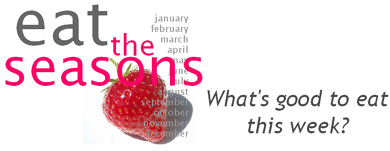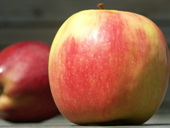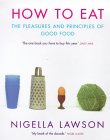
UK/Ireland
•Canada/USA
________________________________________________________________________

eat apples
You may need to look
beyond the supermarket shelves to find them, but there are an exciting
variety of apples available - sharp, sweet, crunchy, soft, red, yellow,
green and everything in between. Many are perfect for enjoying on their
own as a delicious, healthy, energy-boosting snack. And when used as an
ingredient they can be transformed into some of THE great desserts (see
PICK OF THE RECIPES), combining magically with flavors such as caramel,
cinnamon or blackberries.
HISTORY
Although the origins of the apple are not clear, it is almost certainly one of the first fruits to have been cultivated. Apples were a favorite of the ancient Greeks and considered a luxury fruit by the Romans.
The apples familiar to us are a cultivated product, far removed from the small, sour crab apples that were the wild ancestors. Today apples are grown across the globe outside of tropical regions. China is by far the largest apple producing country, responsible for over 40% of the world's output.
BIOLOGY
The apple (Malus pumila) is a member of the Rosaceae family, which includes roses, strawberries, raspberries, apricots, plums and pears. There are thought to be over 7,000 varieties of apple.
NUTRITION
Apples are rich in sugars (glucose, fructose, and sucrose). They contain useful amounts of fiber, vitamin C and potassium. Guercetin, a flavonoid that may help protect against heart disease, is also present.
TIPS
BUYING
The apples sold in supermarkets are varieties developed for good disease
resistance or storage properties, often at the expense of flavor. As Elspeth
Huxley (author of The
Flame Trees of Thika and other books) wrote: "You cannot
sell a blemished apple in the supermarket, but you can sell a tasteless
one provided it is shiny, smooth, even, uniform and bright."
For more interesting and flavorsome varieties, look out for growers' stalls
in farmers' markets or visit a pick your own orchard.
Apples should be firm with taught unbroken skins. Many varieties have naturally freckled or dull matt surfaces - don't shy away from those without the high-sheen finish supermarkets have led us to expect. The odd blemish on apples grown with low/no pesticides is nothing to be afraid of. The fragrance of an apple is a good indicator of freshness and quality.
STORING
Apples should be kept cool, in a plastic bag, in the fridge (or larder
or garage) rather than the fruit bowl - the rate at which apples lose
flavor and juiciness is proportional to the temperature at which they
are stored. Apples are much less perishable than most fruit and many varieties
will keep for a month or longer if bought fresh (those sold in shops may
have been in storage for some time) and kept cool.
PREPARING
Give apples a thorough scrub and rinse - apple trees are often treated
with an aggressive program of chemical sprays.
If peeling or slicing apples, drop the pieces in water acidulated with lemon juice to help prevent them oxidizing (and so discoloring). Apple seeds contain amygdalin, a naturally occurring cyanide and sugar compound that degrades into hydrogen cyanide, so are best avoided.
OTHER STUFF
Although there are thought to be more than 2,500 apple varieties in North America, only around 100 are grown commercially and less than a dozen varieties account for more than 90% of production.
PICK OF THE RECIPES
in
season:
january
february
march
april
may
june
july
august
september
october
november
december
main regions:
Eastern Canada, North Eastern USA
ONLINE
IN PRINT
-
Rice Pudding with Butterscotch Apples
The River Cottage Year -
Baked Caramel Apples
How to Eat


